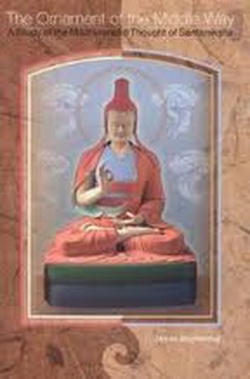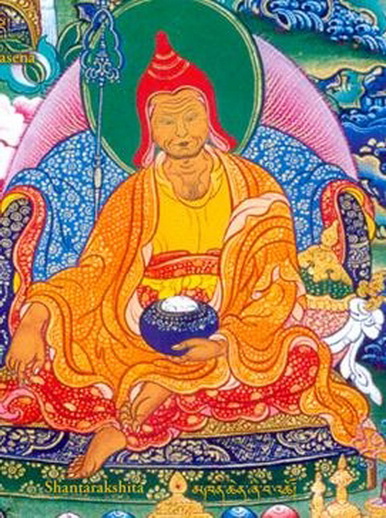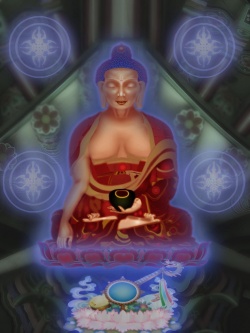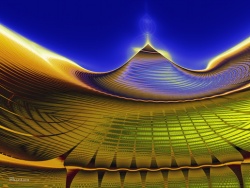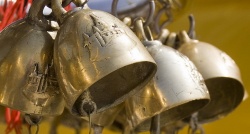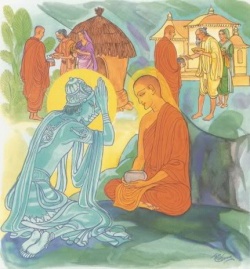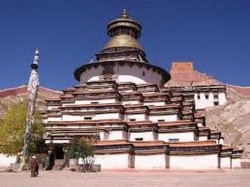Difference between revisions of "Śāntarakṣita"
| (22 intermediate revisions by 4 users not shown) | |||
| Line 1: | Line 1: | ||
| − | + | [[File:Śāntarakṣita13.jpg|thumb|250px|]] | |
| − | + | [[Image:Shantarakshita.JPG|frame|Shantarakshita]]<nomobile>{{DisplayImages|4289|1060|3751|189|3225|3443}}</nomobile> | |
| − | |||
| − | |||
| − | |||
| − | |||
| − | |||
| − | |||
| − | |||
| − | |||
| − | + | '''[[Shantarakshita]]''' (Skt. ''[[Śāntarakṣita]]''; Tib. {{BigTibetan|[[ཞི་བ་འཚོ་]]}}, ''[[Shyiwa Tsho]]'', [[Wyl.]] ''[[zhi ba 'tsho]]''), also called [[Khenpo Bodhisattva]], ‘[[Bodhisattva Abbot]]’. | |
| − | + | This great [[Indian]] [[pandita]] of the [[Mahayana]] school was [[abbot]] of the [[Buddhist]] {{Wiki|university}} of [[Nalanda]]. | |
| − | + | He was invited to [[Tibet]] by [[King Trisong Detsen]] where he founded the [[temple]] and [[monastery]] of [[Samyé]] and [[ordained]] the [[Seven men to be tested|first seven Tibetan monks]], thus establishing the [[Tibetan]] [[Sangha]], according to [[Nagarjuna]]’s [[Sarvastivadin]] [[tradition]]. | |
| − | + | He worked extensively to uphold and maintain the [[Buddhist teachings]], and so began to establish the [[Buddhadharma]] in [[Tibet]]. | |
| − | |||
| − | |||
| − | + | However, indigenous forces that opposed and were {{Wiki|hostile}} to the [[Dharma]] were increasing in strength. | |
| − | + | Neither the might of the [[king]], [[Trisong Detsen]], nor the power of the great [[abbot]] [[Shantarakshita]] could subdue them, and so they invited [[Guru Rinpoche]] to come to [[Tibet]].<ref>See pages 13-14 and 32-33 of ''[[A Great Treasure of Blessings]]''.</ref> | |
| − | + | ==Writings== | |
| − | + | *[[Compendium on Reality]] ([[Tattvasamgraha]]) | |
| + | *[[Ornament of the Middle Way]] | ||
| + | *[[Tattvasiddhi]] | ||
| − | + | ==Notes== | |
| − | |||
| − | |||
| − | |||
| − | |||
| − | |||
| − | [[ | + | <small><references/></small> |
| + | |||
| + | ==Further Reading== | ||
| + | |||
| + | *''[[Śāntarakṣita]]: His [[Life]] and Work'', edited by [[Hari Shankar Prasad]] (collected articles in {{Wiki|Hindi}}, English and [[Tibetan]]), {{Wiki|Tibet House}}, [[New Dehli]], 2003. | ||
| + | |||
| + | *[[Lobsang N. Tsonawa]], ''[[Indian Buddhist Pandits from The Jewel Garland of Buddhist History]]'', {{Wiki|Dharamsala}}: {{Wiki|Library of Tibetan Works and Archives}}, 1985. | ||
| + | |||
| + | *[[David Seyfort Ruegg]], ''The {{Wiki|Literature}} of the [[Madhyamaka]] School of [[Philosophy]] in [[India]]'', [[Wiesbaden]]: Harrassowitz, 1981, pp. 88-93 | ||
| + | |||
| + | ==External Links== | ||
| + | |||
| + | *{{TBRC|P5659|TBRC Profile}} | ||
| + | |||
| + | |||
| + | [[Śāntarakṣita]] ([[Sanskrit]]: [[शान्तरक्षित]]) (725-788) was a renowned 8th century [[Indian]] [[Buddhist]] [[Brahmin]] and [[abbot]] of [[Nalanda]] [[University]]. | ||
| + | |||
| + | [[Śāntarakṣita]] founded the [[philosophical]] school known as [[Yogacara]]-[[Svatantrika]]-[[Madhyamaka]], which united the [[Madhyamaka]] [[tradition]] of [[Nagarjuna]], the [[Yogacara]] [[tradition]] of [[Asanga]] and the [[logical]] and {{Wiki|epistemological}} [[thought]] of [[Dharmakirti]]. | ||
| + | |||
| + | He was also instrumental in the introduction of [[Buddhism]] and the [[Sarvastivadin]] [[monastic]] [[ordination]] [[lineage]] to [[Tibet]] which was conducted at [[Samye]]. | ||
| + | |||
| + | |||
| + | [[Padmakara]] Translation Group (2005: p. 3) ground [[Shantarakshita's]] [[Dharma]] in [[Buddhism]] and the [[Hinduism]] from which it, [[Buddhism]], seceded: | ||
| + | |||
| + | |||
| + | : [[Shantarakshita's]] writings, lost for the most part in [[Sanskrit]] but preserved in [[Tibetan]] translation, give {{Wiki|evidence}} of the {{Wiki|encyclopedic}} range of his {{Wiki|learning}}, which embraced all the [[religious]] and [[philosophical]] currents of his [[time]], [[Hindu]] and [[Buddhist]] alike. | ||
| + | |||
| + | == {{Wiki|Nomenclature}}, {{Wiki|orthography}} and {{Wiki|etymology}} == | ||
| + | |||
| + | [[Śāntarakṣita]] ({{Wiki|Devanagari}}: [[शान्तरक्षित]], also called [[Shantarakshita]], [[Santaraksita]], [[Santiraksita]], [[Zhi-ba-tsho]], and [[Acarya Bodhisattva]] ) | ||
| + | |||
| + | |||
| + | * [[Tibetan]]: {{BigTibetan|[[ཞི་བ་ཚོ]]}}, [[Wylie]]: [[zhi ba tsho]] where '[[zhi ba]]' holds the {{Wiki|semantic}} field: beatitude, quiescence, [[inner peace]], [[tranquility]], [[serenity]] and 'tsho' holds the {{Wiki|semantic}} field: complexion, comportment. | ||
| + | |||
| + | |||
| + | == {{Wiki|History}} == | ||
| + | |||
| + | |||
| + | There are few historical records of [[Śāntarakṣita]], with most available {{Wiki|material}} [[being]] from [[Wikipedia:Hagiography|hagiographic]] sources. | ||
| + | |||
| + | Some of his {{Wiki|history}} is detailed in a 19th century commentary by [[Jamgon Ju Mipham Gyatso]] drawn from sources like the [[Blue Annals]], [[Büton]], and [[Taranatha]]. | ||
| + | |||
| + | [[Śāntarakṣita]] was the son of the [[king]] of [[Zahor]]. Some identify '[[Zahor]]' with a place in {{Wiki|ancient}} {{Wiki|Bengal}} | ||
| + | |||
| + | |||
| + | [[Śāntarakṣita]] was brought to [[Tibet]] at the instigation of [[King Trisong Detsen]] sometime before 767 CE. | ||
| + | |||
| + | One account details his first trip as unsuccessful and he spent six years in [[Nepal]] before returning to [[Tibet]]. Once established in [[Tibet]], [[Śāntarakṣita]] oversaw the translation of a large [[body]] of [[scriptures]] into [[Tibetan]]. | ||
| + | |||
| + | He oversaw the construction of the first [[Buddhist]] [[monastery]] at [[Samye]] in 787 CE and [[ordained]] the first [[monastics]] there. | ||
| + | |||
| + | He stayed at [[Samye]] for the [[rest]] of his [[life]], another 13 years after its completion, and this was considered significant by [[Tibetans]] later that he stayed and did not return to [[India]]. | ||
| + | |||
| + | |||
| + | In some accounts he left [[Tibet]] for a [[time]] due to the [[antipathy]] of followers of the [[traditional]] [[Bön]] [[tradition]] and interference from local [[spirits]]. | ||
| + | |||
| + | : He then [[thought]] that a [[teacher]] possessed of super-natural [[powers]] and {{Wiki|mystic}} charms would be [[able]] to move deeply the [[people]] of [[Tibet]], steeped in {{Wiki|sorcery}} {{Wiki|exorcism}} and the like. | ||
| + | |||
| + | Accordingly, he advised the {{Wiki|King}} to invite the celebrated [[Buddhist]] [[teacher]] [[Padmasambhava]] to [[Tibet]] and subdue the [[Tibetan]] {{Wiki|devils}} and [[demi-gods]]. | ||
| + | |||
| + | |||
| + | His [[philosophic]] [[views]] were the main [[views]] in [[Tibet]] from the 8th century until it was mostly supplanted by [[Je Tsongkhapa's]] [[interpretation]] of [[Prasaṅgika]] [[Madhyamaka]] in the 15th century. | ||
| + | |||
| + | In the late 19th century, [[Ju Mipham]] attempted to promote his [[views]] again as part of the [[Rime]] {{Wiki|movement}} and as a way to discuss specific critiques of [[Je Tsongkhapa's]] [[interpretation]] of [[Prasaṅgika]]. | ||
| + | |||
| + | |||
| + | == Teachings == | ||
| + | |||
| + | |||
| + | We know that [[Śāntarakṣita]] focused his early teachings in [[Tibet]] directed to the 'seven that were tested' upon the '[[ten virtues]]' ([[Tibetan]]: {{BigTibetan|[[དགེ་བ་བཅུ]]}}, [[Wylie]]: [[dge ba bcu]]; [[Sanskrit]]: [[daśakuśala]]; [[Pali]]: [[dasa sikkhapadani]] or [[dasa sila]]) and 'the [[chain of casual relation]]' ([[Sanskrit]]: [[pratītyasamutpāda]]). | ||
| + | |||
| + | The [[ten virtues]] are the {{Wiki|opposite}} of the '[[ten non-virtues]]' ([[Tibetan]]: {{BigTibetan|[[མི་དགེ་བ་བཅུ]]}}, [[Wylie]]: [[mi dge ba bcu]]; [[Sanskrit]]: [[daśākuśala]]). | ||
| + | |||
| + | |||
| + | === [[Disciples]] === | ||
| + | |||
| + | [[Haribhadra]] ([[Seng-ge Bzang-po]]) | ||
| + | |||
| + | |||
| + | == [[Views]] == | ||
| + | |||
| + | |||
| + | [[Śāntarakṣita's]] {{Wiki|synthesis}} of [[Madhyamaka]], [[Yogacara]], and [[Pramana]] was expounded in his text [[Madhyamākalaṃkāra]]. Within the [[Yogacara]] in that text he also included the [[Sautrantika]] and "[[consciousness-only]]" [[views]] specifically when referring to '[[conventional truth]]', one of the [[two truths doctrine]]. | ||
| + | |||
| + | His [[view]] is therefore categorized as "[[Yogacara]]-[[Svatantrika]]-[[Madhyamaka]]" by later [[Tibetans]], but he did not refer to himself that way. | ||
| + | |||
| + | |||
| + | In his {{Wiki|synthesis}} text, readers are advised to adopt [[Madhyamaka]] [[view]] and approach from [[Nagarjuna]] and [[Aryadeva]] when analyzing for ultimacy and to adopt the [[mind-only]] [[views]] of the [[Yogacarans]] [[Asanga]] and [[Vasubandhu]] when considering [[conventional truth]]. | ||
| + | |||
| + | He also incorporates the [[logic]] approach of valid [[cognition]] and the [[Sautantrika]] [[views]] of [[Dignāga]] and [[Dharmakirti]]. | ||
| + | |||
| + | |||
| + | [[Śāntarakṣita]] is also known for his text [[Tattvasamgraha]] "Compendium on [[Reality]]", which is a more {{Wiki|encyclopedic}} treatment of the major [[philosophic]] [[views]] of the [[time]] and survived in translation in both [[Tibet]] and [[China]]. | ||
| + | |||
| + | A [[Sanskrit]] version of this work was discovered in 1873 by Dr. G. Bühler in the [[Jain]] [[Dharma]] [[temple]] of [[Parshva]] at [[Jaisalmer]]. This version contains also the commentary by [[Śāntarakṣita's]] pupil [[Kamalaśīla]]. | ||
| + | |||
| + | |||
| + | |||
| + | == [[Ju Mipham's]] Revival of [[Śāntarakṣita's Tradition]] == | ||
| + | |||
| + | |||
| + | |||
| + | In the 19th century, a {{Wiki|movement}} funded by the {{Wiki|secular}} authorities in [[Derge]], [[Kham]] began to establish centers of {{Wiki|learning}} encouraging the study of [[traditions]] different from the dominant [[Gelug tradition]] in {{Wiki|central}} [[Tibet]]. | ||
| + | |||
| + | This now called [[rime]] {{Wiki|movement}} revitalized the [[Sakya]], [[Kagyu]], and [[Nyingma traditions]] who had been by almost supplanted by the [[Gelug]] hegemony. | ||
| + | |||
| + | As part of that {{Wiki|movement}} the 19th century [[Nyingma]] [[scholar]] [[Ju Mipham]] wrote the first commentary in almost 400 years about [[Shantarakshita's]] [[Madhyamakalankara]]. | ||
| + | |||
| + | According to his [[student]] [[Kunzang Palden]], [[Mipham]] had been asked by his [[teacher]] [[Jamyang Khyentse Wangpo]] to write a survey of all the major [[Mahayana]] [[philosophic]] [[shastras]] for use in the [[Nyingma]] [[monastic]] {{Wiki|colleges}}. | ||
| + | |||
| + | [[Mipham's]] commentaries now [[form]] the {{Wiki|backbone}} of the [[Nyingma]] [[monastic]] {{Wiki|curriculum}}. | ||
| + | |||
| + | [[Shantarakshita's]] [[Madhyamakalankara]], which was almost forgotten by the 19th century, is now studied by all [[Nyingma]] [[shedra]] students. | ||
| + | {{W}} | ||
| + | |||
| + | [[Category:Tibetan Buddhist History]] | ||
| + | [[Category:Śāntarakṣita]] | ||
Latest revision as of 02:45, 24 December 2015
Shantarakshita (Skt. Śāntarakṣita; Tib. ཞི་བ་འཚོ་, Shyiwa Tsho, Wyl. zhi ba 'tsho), also called Khenpo Bodhisattva, ‘Bodhisattva Abbot’.
This great Indian pandita of the Mahayana school was abbot of the Buddhist university of Nalanda.
He was invited to Tibet by King Trisong Detsen where he founded the temple and monastery of Samyé and ordained the first seven Tibetan monks, thus establishing the Tibetan Sangha, according to Nagarjuna’s Sarvastivadin tradition.
He worked extensively to uphold and maintain the Buddhist teachings, and so began to establish the Buddhadharma in Tibet.
However, indigenous forces that opposed and were hostile to the Dharma were increasing in strength.
Neither the might of the king, Trisong Detsen, nor the power of the great abbot Shantarakshita could subdue them, and so they invited Guru Rinpoche to come to Tibet.[1]
Writings
Notes
- ↑ See pages 13-14 and 32-33 of A Great Treasure of Blessings.
Further Reading
- Śāntarakṣita: His Life and Work, edited by Hari Shankar Prasad (collected articles in Hindi, English and Tibetan), Tibet House, New Dehli, 2003.
- Lobsang N. Tsonawa, Indian Buddhist Pandits from The Jewel Garland of Buddhist History, Dharamsala: Library of Tibetan Works and Archives, 1985.
- David Seyfort Ruegg, The Literature of the Madhyamaka School of Philosophy in India, Wiesbaden: Harrassowitz, 1981, pp. 88-93
External Links
Śāntarakṣita (Sanskrit: शान्तरक्षित) (725-788) was a renowned 8th century Indian Buddhist Brahmin and abbot of Nalanda University.
Śāntarakṣita founded the philosophical school known as Yogacara-Svatantrika-Madhyamaka, which united the Madhyamaka tradition of Nagarjuna, the Yogacara tradition of Asanga and the logical and epistemological thought of Dharmakirti.
He was also instrumental in the introduction of Buddhism and the Sarvastivadin monastic ordination lineage to Tibet which was conducted at Samye.
Padmakara Translation Group (2005: p. 3) ground Shantarakshita's Dharma in Buddhism and the Hinduism from which it, Buddhism, seceded:
- Shantarakshita's writings, lost for the most part in Sanskrit but preserved in Tibetan translation, give evidence of the encyclopedic range of his learning, which embraced all the religious and philosophical currents of his time, Hindu and Buddhist alike.
Nomenclature, orthography and etymology
Śāntarakṣita (Devanagari: शान्तरक्षित, also called Shantarakshita, Santaraksita, Santiraksita, Zhi-ba-tsho, and Acarya Bodhisattva )
- Tibetan: ཞི་བ་ཚོ, Wylie: zhi ba tsho where 'zhi ba' holds the semantic field: beatitude, quiescence, inner peace, tranquility, serenity and 'tsho' holds the semantic field: complexion, comportment.
History
There are few historical records of Śāntarakṣita, with most available material being from hagiographic sources.
Some of his history is detailed in a 19th century commentary by Jamgon Ju Mipham Gyatso drawn from sources like the Blue Annals, Büton, and Taranatha.
Śāntarakṣita was the son of the king of Zahor. Some identify 'Zahor' with a place in ancient Bengal
Śāntarakṣita was brought to Tibet at the instigation of King Trisong Detsen sometime before 767 CE.
One account details his first trip as unsuccessful and he spent six years in Nepal before returning to Tibet. Once established in Tibet, Śāntarakṣita oversaw the translation of a large body of scriptures into Tibetan.
He oversaw the construction of the first Buddhist monastery at Samye in 787 CE and ordained the first monastics there.
He stayed at Samye for the rest of his life, another 13 years after its completion, and this was considered significant by Tibetans later that he stayed and did not return to India.
In some accounts he left Tibet for a time due to the antipathy of followers of the traditional Bön tradition and interference from local spirits.
- He then thought that a teacher possessed of super-natural powers and mystic charms would be able to move deeply the people of Tibet, steeped in sorcery exorcism and the like.
Accordingly, he advised the King to invite the celebrated Buddhist teacher Padmasambhava to Tibet and subdue the Tibetan devils and demi-gods.
His philosophic views were the main views in Tibet from the 8th century until it was mostly supplanted by Je Tsongkhapa's interpretation of Prasaṅgika Madhyamaka in the 15th century.
In the late 19th century, Ju Mipham attempted to promote his views again as part of the Rime movement and as a way to discuss specific critiques of Je Tsongkhapa's interpretation of Prasaṅgika.
Teachings
We know that Śāntarakṣita focused his early teachings in Tibet directed to the 'seven that were tested' upon the 'ten virtues' (Tibetan: དགེ་བ་བཅུ, Wylie: dge ba bcu; Sanskrit: daśakuśala; Pali: dasa sikkhapadani or dasa sila) and 'the chain of casual relation' (Sanskrit: pratītyasamutpāda).
The ten virtues are the opposite of the 'ten non-virtues' (Tibetan: མི་དགེ་བ་བཅུ, Wylie: mi dge ba bcu; Sanskrit: daśākuśala).
Disciples
Views
Śāntarakṣita's synthesis of Madhyamaka, Yogacara, and Pramana was expounded in his text Madhyamākalaṃkāra. Within the Yogacara in that text he also included the Sautrantika and "consciousness-only" views specifically when referring to 'conventional truth', one of the two truths doctrine.
His view is therefore categorized as "Yogacara-Svatantrika-Madhyamaka" by later Tibetans, but he did not refer to himself that way.
In his synthesis text, readers are advised to adopt Madhyamaka view and approach from Nagarjuna and Aryadeva when analyzing for ultimacy and to adopt the mind-only views of the Yogacarans Asanga and Vasubandhu when considering conventional truth.
He also incorporates the logic approach of valid cognition and the Sautantrika views of Dignāga and Dharmakirti.
Śāntarakṣita is also known for his text Tattvasamgraha "Compendium on Reality", which is a more encyclopedic treatment of the major philosophic views of the time and survived in translation in both Tibet and China.
A Sanskrit version of this work was discovered in 1873 by Dr. G. Bühler in the Jain Dharma temple of Parshva at Jaisalmer. This version contains also the commentary by Śāntarakṣita's pupil Kamalaśīla.
Ju Mipham's Revival of Śāntarakṣita's Tradition
In the 19th century, a movement funded by the secular authorities in Derge, Kham began to establish centers of learning encouraging the study of traditions different from the dominant Gelug tradition in central Tibet.
This now called rime movement revitalized the Sakya, Kagyu, and Nyingma traditions who had been by almost supplanted by the Gelug hegemony.
As part of that movement the 19th century Nyingma scholar Ju Mipham wrote the first commentary in almost 400 years about Shantarakshita's Madhyamakalankara.
According to his student Kunzang Palden, Mipham had been asked by his teacher Jamyang Khyentse Wangpo to write a survey of all the major Mahayana philosophic shastras for use in the Nyingma monastic colleges.
Mipham's commentaries now form the backbone of the Nyingma monastic curriculum.
Shantarakshita's Madhyamakalankara, which was almost forgotten by the 19th century, is now studied by all Nyingma shedra students.
